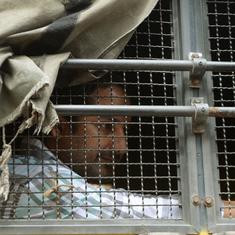Of these, the rudra veena, also called the been, dates back several centuries. It does not enjoy the popularity of the sitar, sarod or santoor, but it continues to be played to this day by musicians belonging to lineages specialising in the dhrupad form or by those trained in this form. The deep tonal quality of the instrument lends itself eminently to the austere expansion of the raag explored by practitioners of dhrupad.
We are fortunate to have access to audio recordings of rudra veena players dating back to the early twentieth century. But let us begin with more recent video recordings.
Zia Mohiuddin Dagar
Raag Yaman
The total length of this recording has been divided over seven clips.
Zia Mohiuddin Dagar belonged to the illustrious Dagar lineage that has for several generations been devoted to the dhrupad form. A renowned rudra veena player in the second half of the twentieth century, Zia Mohiuddin Dagar was also greatly responsible for introducing the instrument and dhrupad to many non-Indian audiences. Here is a detailed exploration of the aalaap in raag Yaman.
Asad Ali Khan
Raag Multani
A contemporary of Zia Mohiuddin Dagar, Asad Ali Khan was a major votary of the dhrupad genre and the rudra veena. On this track, he plays an extensive aalaap in raag Multani followed by a dhrupad composition in the 12-count cycle called Choutaal. He is accompanied by Mohan Shyam Sharma on the pakhawaj.
Asad Ali Khan
Raag Yaman
We return to raag Yaman, a major raag in the Hindustani tradition that is often taught first to any student. But here, we have a rare archival audio recording of Asad Ali Khan accompanying his father Sadiq Ali Khan. The virtuosic style of the Jaipur Beenkaar gharana maestro accompanied on the pakhawaj by Ayodhya Prasad, is noticeable particularly in the latter section of the recording where there is significant rhythmic interplay between Sadiq Ali Khan’s right-hand strokes and the pakhawaj syllables.
Mohammad Dabir Khan
Raag Shuddha
Mohammad Dabir Khan was a descendant of Mia Tansen, the court musician at Emperor Akbar’s darbar. This is an archival recording of Mohammad Dabir Khan playing the afternoon raag Shuddha Sarang on the rudra veena. He begins with an aalaap followed by a taar paran section that involves a rhythmic exploration not set to any particular time cycle but accompanied by the pakhawaj. This recording also includes his vocal rendition of the raag Lalita Gauri and another rudra veena recital featuring raag Shree.
Mohammad Khan Faridi Desai
Raag Hanskinkini
This track featuring Mohammad Khan Faridi Desai is also an archival recording. He plays the raag Hanskinkini, a melody rarely heard today. The second raag on the same recording is Bhairavi.
Abdul Karim Khan
We conclude with a rudra veena recital by Abdul Karim Khan, who is more popularly known as the leading light of the Kirana gharana khayal tradition.
Many of the tracks included above have detailed accompanying text, which readers might find useful.










